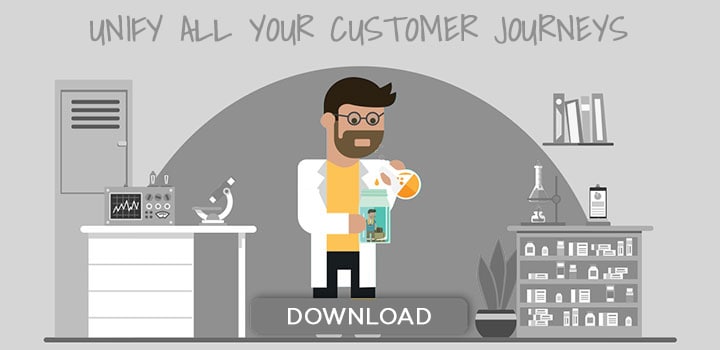Home > Blog > Info > La raccolta dati 1st party
These last few years, digital marketing kept evolving and data has proved to be an undeniable asset for companies. Moreover, the idea of ensuring a digital transformation within companies (which, between us, should already be done) is relegated to the benefit of a more specific objective: becoming data-driven companies, piloted by the data.
Our environment is totally digitized, it is a fact. Online shopping and digital advertising have never been so big. Business and marketing strategies, especially those of emerging companies, also start by taking into account online interactions (Web, mobile, applications, e-commerce, online campaigns, …) before all those that are offline (eg shopping in shops).
In this digital age in which we evolve, it’s difficult not to consider the data as godsend. They are the key to optimize marketing strategies, growth and business success.
DOWNLOAD THE WHITE PAPER: UNIFY ALL YOUR CUSTOMER JOURNEYS
In this scenario, data collection becomes one of the pillars of our marketing strategies. It seems obvious that: the more data we can collect (e.g., ad centric, centric site, user centric, CRM), the more our ecosystem becomes clearer and easily addressable (with the right message at the right time). Making the right decisions to optimize marketing strategies and achieve a data-driven growth then seems reachable for everyone.
Yet, it is far from being so simple. As mentioned, data have become a valuable asset for businesses and users know it. Above all, they know that their journeys on the internet are studied and analyzed. And that, they do not appreciate. Thus, they are more and more attentive to the data they share and with whom they share it.
As proof: the increasing use of AdBlockers, worldwide. About 30% of French Internet users use them.
In response to this climate of mistrust but also to the growing importance of user data protection and the pressure of the European institutions (GDPR), new native features within browsers (eg Safari with ITP, Chrome or Firefox ), which can clearly impact the collection of data, have gradually begun to emerge. The advertisers then saw themselves slipping slowly into a rather delicate situation.
DISCOVER THE IMPACTS OF THE ITP 2.2 FOR ADVERTISERS
In this context, they must review their copy and adapt if they do not want to see this pillar (represented by the data) crumbling, thus “collapsing” their company. They need to be transparent to users and allow them to decide how to handle their own data.
Data collection becomes an increasingly difficult task, at least if you want to do it exhaustively and accurately (yes, it is possible to do both). For this reason, there is a need to review existing types of data collection and their benefits (taking care not to confuse collection types with data types).
THE THIRD PARTY COLLECTION
This type of collection is done under the domain name of a third party, and not of the advertiser (e.g. collection.com vs. advertiser.com). It concerns the majority of advertising partners involved in digital campaigns, as well as the vast majority of technology partners used to optimize online strategies (TMS, analytical tools, etc.).
Let’s take an example:
Any advertiser, with a web page, doing their analytics with Google, or another similar tool, will collect data for their analytics via a domain similar to: google.analytics.com – so with a domain name other than: advertiser .com and thus considered as third party. In the same way, ad platforms collect campaign data using a different domain from the website where they appear. This is the key to a third party collection.
What does it mean for the advertiser ?
All of these tools or platforms that collect data in this way will ultimately only have access to 30% of the ones they could collect (according to an Eulerian study). This is due, remember, to the fearsome Adblockers and native blockers of the browsers mentioned above that block calls to third party tags.
In addition, it should be noted that, in the case of advertising platforms, the data collected is not entirely the property of the advertiser but is also shared with these platforms thus making it difficult to control them. This is somewhat inconsistent with what the new data privacy legislation aims to achieve, namely, greater transparency and clarity for users as to the location and availability of their data.
THE FIRST PARTY COLLECTION
For its part, the collection of data in first party is done under the domain name of the advertiser. This means that the data is the property of the advertiser and is collected as such (the term “first party” starts to make sense, isn’t it?). Thus, for a technological tool (not directly linked to the site) to collect all the data without suffering the activities of adblockers, it must be able to set up a collection of this type.
How? Thanks to a delegation of domain
Let’s take an example, still with our website advertiser.com:
To collect in first party, it is necessary to set up a delegation, an alias, via a subdomain of the advertiser, as for example: www.plateforme.advertiser.com. The collection taking place under the name of the advertiser, and not under a third party, neither the Adblockers nor the browsers, interrupt the calls of tags. The access to the data is possible.
This factually translates into an increase in the amount of data collected and, therefore, a much more real and accurate view of what is happening in the online environment. Because yes, having more data is good, but it is really the use we make of these data that is important and especially the reliability of the analyzes that emerge. As proof, think about the medical world and the research that is done daily. Don’t you think that with 70% participation at least the results are not totally biased? Don’t you think we can go from a large sample of people who might be receptive (or not) to treatment? It’s exactly the same (obviously different) for marketing campaign analytics. By missing out on this data, you could also miss out on a nice target that’s receptive to your campaigns.
These data and their significant analyzes make it possible to make informed decisions in order to optimize the marketing strategies thanks to a better knowledge of the users and the customer journey: more data, more reliability in the analyzes, more efficiency at the level of the campaigns and more conversions.
Furthermore, it should also be noted that with this form of collection (carried out via a sub-domain of the advertiser), the data is entirely owned and managed by the advertiser. However, it is important to specify, and even more with the entry into force of the GDPR, that if these data belong to it, they belong above all and first to the user. With this in mind, advertisers must be transparent and provide all the information that a user would like to obtain.
If marketing technologies makes it possible to obtain precise information in terms of collection and analysis (especially of marketing attribution), it is important that they can remain neutral with regard to the results. Indeed, it seems complex to be objective when one is both player and referee. Having a neutral analysis is however crucial to be able to measure to optimize the media ecosystem and, consequently, the data-driven growth.
DISCOVER WHAT CORRESPONDS THE MARKETING ATTRIBUTION
CONCLUSION
Thus, first-party data collection brings many benefits:
- More data collected, more accurate analysis and optimization of ROI & conversion
- Tranquility and transparency in the face of new privacy legislation in force
- Neutrality and accuracy in the valuation of its channels
Finally, it is important to emphasize the importance of having a technology that collects in centralized first party, but also allows to collect and reunite the entire Customer Journey whatever the device or data (eg ad centric, centric site, user centric, television, point of sale, call center) so that all aspects of the media ecosystem can be exploited effectively.





